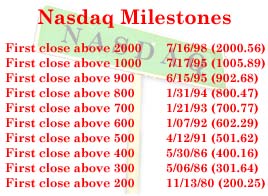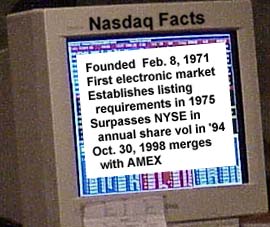|
Change comes to Wall St.
|
 |
November 3, 1999: 3:47 p.m. ET
In its short history, Nasdaq has become a very competitive No. 2
By Staff Writer Jeanne Sahadi
|
NEW YORK (CNNfn) - The Nasdaq Stock Exchange is a little like some 28-year-old Internet billionaire you hear so much about these days -- both were born in 1971, and both are revolutionizing Wall Street.
Just as the business boy-wonder is to the Rockefellers, the Nasdaq, the world's first electronic stock market, has proved to be the brash, new-money upstart that chips away at the coveted position of Wall Street society's patriarch, the New York Stock Exchange.
What began as a dealer quote system has evolved into a stock trading execution system that looks more and more like the NYSE, said Patrick Healy, president of the Issuer Network, which consults with companies on which exchange to choose and other stock-related issues.
"The growth has been impressive, to say the least," Healy said. "Nasdaq is a very, very good competitor. It's good for the markets."
Nasdaq has made several changes in recent years to make itself a tougher contender, including raising its fees and listing standards, which always have been lower than those of the NYSE, and still are for the most part.
Much like the rivalry between car rental agencies Hertz and Avis, Healy said, "No. 2 is trying really hard here."

A quick look at Nasdaq's recent history gives some perspective on just how far the market has come since its salad days.
- More than half of all the shares traded each day in the United States now trade on Nasdaq, which is run by the National Association of Securities Dealers. Just last week, daily share volume exceeded 1.438 billion shares, more than has ever traded on any equities market in a single day.
- The number of companies listed on the Nasdaq has risen from 2,500 in 1971 to 4,845 today, making it the No. 1 market in terms of company listings. But that position is held "primarily because listing standards are materially lower" than those for the NYSE, Healy said, which means companies that don't make the grade either in terms of earnings or equity capitalization don't get to join the NYSE.
- Total market cap on the Nasdaq has grown to over $3.7 trillion, though it is still a distant second to the more than $15 trillion racked up by the NYSE, which represents approximately 80 percent of the value of all publicly owned companies. And should any of Nasdaq's most widely held companies choose to de-list, Healy noted, the exchange's market cap would be reduced notably.
- The Nasdaq has been home to many of the leading first-day gainers among initial public offerings, including the recent debut of Akamai Technologies (AKAM).
- As of Nov. 2, the benchmark Nasdaq Composite posted 32 record closing highs, one better than the Dow Jones Industrial Average.
- In 1998, the NASD and the American Stock Exchange merged to create the world's first financial exchange that brings together a central auction specialist system, like that used by AMEX and the NYSE, and the multiple market-maker system, as used by Nasdaq. AMEX and Nasdaq continue to operate as separate markets but under the management of an NASD subsidiary.
- An added dash of prestige
The status of Nasdaq -- which has been built on the market's reputation as a key engine powering the bull market and as a bellwether for the technology sector -- got an added boost last week, from news that heavyweights Microsoft (MSFT) and Intel (INTC) would be added to the 103-year-old Dow Jones industrial average. The additions mark the first time Nasdaq stocks have been included in the world's most widely watched index.

The move comes at a time when Nasdaq and the NYSE compete for investor dollars, both with each other and a host of other trading systems.
To date, the Nasdaq has seen more of its listed companies switch to the NYSE than the other way around.
That's because the NYSE, founded in 1792, has become the world's biggest and best-known stock market. It still has the upper hand when it comes to prestige and it is generally less volatile than the dot.com-heavy Nasdaq.
But if a company wants to leave the NYSE, it has to meet stringent requirements under the regulation known as Rule 500. Should amendments to that rule be approved, the flow of traffic may become a bit more fluid in Nasdaq's direction, some say.
Companies, particularly lesser known ones, may choose -- or be forced -- to trade on the Nasdaq in part for its lesser listing requirements but also for the market's promotion capabilities, thanks to a combined system of "market-makers" -- middleman broker-dealer firms that openly compete for investors' buy and sell orders -- and access to electronic communications networks (ECNs), which let equity buyers and sellers meet without the use of middlemen.
With many market players trading a company's shares -- on average 11 market makers trade a stock -- an issue can receive greater access to available capital, increased visibility in the marketplace, and access to immediate and continuous trading.
Future holds longer days
And that concept of "continuous" is becoming all-important in the bid for investor dollars, particularly as the number of competing electronic trading systems grows.
With the explosion of individuals investing online, major markets are being forced to respond to a push for longer trading days, although they haven't committed yet to a definite time to expand hours.
At the end of October, however, the Nasdaq took its first step and began reporting after-hours stock quotes, a service previously provided only by a handful of firms like Instinet and in a less-than-unified manner.
By providing all investors with the same information at the same time -- as the new ticker system is designed to do -- like the Nasdaq itself, it is set to help pioneer the next stage in trading. 
|
|
|
|
|
|
Nasdaq
Nasdaq News.com
|
Note: Pages will open in a new browser window
External sites are not endorsed by CNNmoney
|
|
|
|
 |

|

